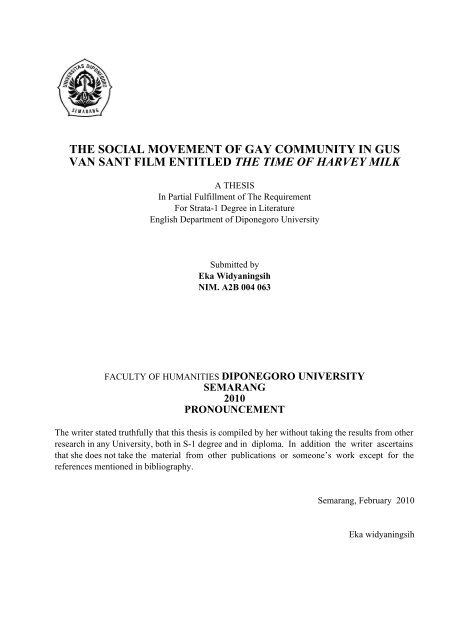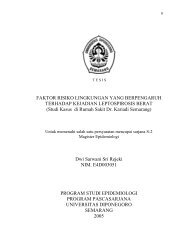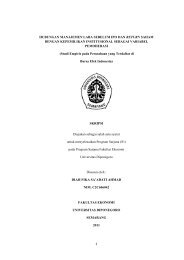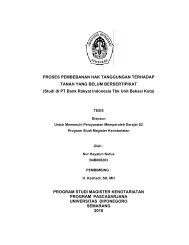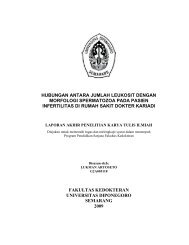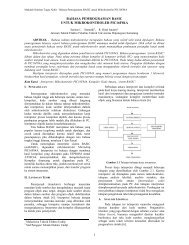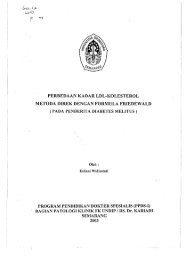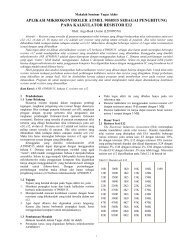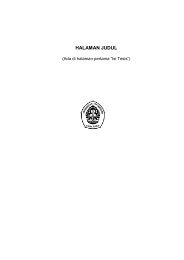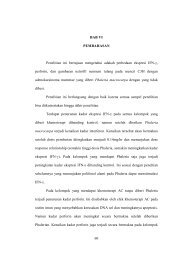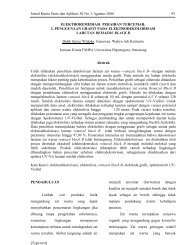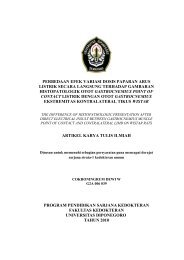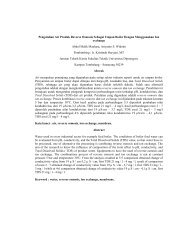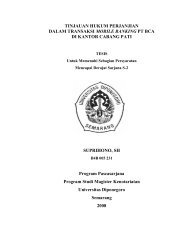the social movement of gay community in gus van sant film entitled ...
the social movement of gay community in gus van sant film entitled ...
the social movement of gay community in gus van sant film entitled ...
Create successful ePaper yourself
Turn your PDF publications into a flip-book with our unique Google optimized e-Paper software.
THE SOCIAL MOVEMENT OF GAY COMMUNITY IN GUS<br />
VAN SANT FILM ENTITLED THE TIME OF HARVEY MILK<br />
A THESIS<br />
In Partial Fulfillment <strong>of</strong> The Requirement<br />
For Strata-1 Degree <strong>in</strong> Literature<br />
English Department <strong>of</strong> Diponegoro University<br />
Submitted by<br />
Eka Widyan<strong>in</strong>gsih<br />
NIM. A2B 004 063<br />
FACULTY OF HUMANITIES DIPONEGORO UNIVERSITY<br />
SEMARANG<br />
2010<br />
PRONOUNCEMENT<br />
The writer stated truthfully that this <strong>the</strong>sis is compiled by her without tak<strong>in</strong>g <strong>the</strong> results from o<strong>the</strong>r<br />
research <strong>in</strong> any University, both <strong>in</strong> S-1 degree and <strong>in</strong> diploma. In addition <strong>the</strong> writer ascerta<strong>in</strong>s<br />
that she does not take <strong>the</strong> material from o<strong>the</strong>r publications or someone’s work except for <strong>the</strong><br />
references mentioned <strong>in</strong> bibliography.<br />
Semarang, February 2010<br />
Eka widyan<strong>in</strong>gsih
APPROVAL<br />
Approved by:<br />
Advisor,<br />
Arido Laksono S.S, M.Hum.<br />
NIP. 1999031002
ACCEPTANCE<br />
Accepted by:<br />
Strata-1 Thesis Exam<strong>in</strong>ation Commitee<br />
English Department<br />
Faculty <strong>of</strong> Humanities, Diponegoro University<br />
On February, 2010<br />
Chairman,<br />
Dra. Dewi Murni, MA<br />
NIP.194912071976032001<br />
|First Member, |Second Member |<br />
| | |<br />
| | |<br />
| | |<br />
| | |<br />
|Arido Laksono, SS, M. Hum |Drs. Siswo Harsono |<br />
| | |<br />
|NIP. 197507111999031002 |NIP. 196404181990011001 |<br />
| | |<br />
| | |
MOTTO AND DEDICATION<br />
MOTTO<br />
Mistake is a way to learn and to be better (anonym)<br />
Cogito Ergo Sum (Rene Descartes)<br />
Cara terbaik untuk mewujudkan impian kita adalah segera<br />
bangun, dan bekerja keras (Mario Teguh)<br />
DEDICATION<br />
This <strong>the</strong>sis is dedicated to<br />
God Almighty<br />
Beloved parents and bro<strong>the</strong>rs<br />
Beloved husband, daughter and son<br />
All best friends
ACKNOWLEDGEMENT<br />
Praise be to Allah SWT who has given strength and true spirit so <strong>the</strong> writer can f<strong>in</strong>ish her<br />
<strong>the</strong>sis <strong>entitled</strong> The Social Movement Of Gay Community In Gus Van Sant Film Entitled The<br />
Time <strong>of</strong> Harvey Milk. Without His unceas<strong>in</strong>g bless<strong>in</strong>gs, <strong>the</strong> writer will absolutely fail to survive<br />
from obstacles, especially <strong>in</strong> mak<strong>in</strong>g this <strong>the</strong>sis. The writer’s extremely deep gratitude also goes to<br />
<strong>the</strong> follow<strong>in</strong>g:<br />
1. Pr<strong>of</strong>. Dr. Nurdien H. K. M. A, as <strong>the</strong> Dean <strong>of</strong> Faculty <strong>of</strong> Humanities, Diponegoro<br />
University Semarang.<br />
2. Drs. Mualim<strong>in</strong>, M. Hum, as <strong>the</strong> Head <strong>of</strong> English Department, Faculty <strong>of</strong> Humanities,<br />
Diponegoro University Semarang.<br />
3. Sukarni Suryan<strong>in</strong>gsih, S.S, M. Hum as <strong>the</strong> Head <strong>of</strong> American Studies Section <strong>of</strong><br />
English Department, Faculty <strong>of</strong> Humanities, Diponegoro University Semarang.<br />
4. Drs. Sunarwoto, M. S, M. A as <strong>the</strong> writer’s Academic Supervisor.<br />
5. Arido Laksono, S. S, M. Hum as her Thesis Advisor who has guided and encouraged<br />
<strong>the</strong> writer <strong>in</strong> creat<strong>in</strong>g a better writ<strong>in</strong>g. He gave some vital corrections to improve both <strong>the</strong> contents<br />
and <strong>the</strong> language structure <strong>of</strong> <strong>the</strong> <strong>the</strong>sis, without which it is doubtful that this <strong>the</strong>sis come <strong>in</strong>to<br />
completion.<br />
6. All lecturers <strong>of</strong> The English Department, Faculty <strong>of</strong> Humanities, Diponegoro<br />
University Semarang who have shared <strong>the</strong>ir knowledge and even moral values to<br />
<strong>the</strong> writer.<br />
7. The staff <strong>of</strong> The Library <strong>of</strong> Faculty <strong>of</strong> Humanities, Diponegoro University Semarang<br />
who lent <strong>the</strong> writer many valuable books and o<strong>the</strong>r literary sources;<br />
8. The writer’s beloved husband Wahdan Yudho Kusumo, SH, little girl Sadira Naafi’<br />
Kusuma and baby boy Dityaga Febian Kusuma who have been so patient to be ignored while <strong>the</strong><br />
writer was bussy <strong>in</strong> f<strong>in</strong>ish<strong>in</strong>g <strong>the</strong> <strong>the</strong>sis. They have provided <strong>the</strong> support and spirit for <strong>the</strong> writer.<br />
9. The writer’s beloved parents, Bapak Untung Pramono and Ibu Hanik Zulaikah, who<br />
have given <strong>the</strong>ir boundless love and affection; and two car<strong>in</strong>g bro<strong>the</strong>rs , Dwi Bayu Prasetyo and<br />
Danu Triatmojo Pramono, who have provided her with assistances both physically and mentally.<br />
10. The writer’s big family which consists <strong>of</strong> Parents <strong>in</strong> Law; Mohammad Alfan Wazid<br />
and Dyah Koemorowati who have given <strong>the</strong>ir support, Aunties; Sylvia Au<strong>gus</strong>t<strong>in</strong>e Messak, Endah<br />
Kusumastuti Handayani, Endang Retno Sumilih and Eyang Bambang Kumoro also An<strong>in</strong>dita<br />
Pradana.<br />
11. The writer’s partner who has accompanied her through <strong>the</strong> ‘f<strong>in</strong>al battle’ Clarisa<br />
Mel<strong>in</strong>da Ramdhon for <strong>the</strong> support and advice that mean a lot for <strong>the</strong> writer.<br />
12. The writer’s friends <strong>in</strong> Strata-1 English Department 2004, namely Ba<strong>gus</strong> Prasetya,<br />
Ardi Darmawan, Riant<strong>in</strong>e, Agung, Yesca, Kris, Rika, Primy, Yesti, Mila, Popo, Ba<strong>gus</strong> Gede,<br />
Galuh, Dyah, Erna, Nita, Leo, Banu, Idris, Kesong, Puput; and her o<strong>the</strong>r sympa<strong>the</strong>tic friends<br />
S<strong>in</strong>ta, Sylvi, Ruly, Cacho, Wulan, Yonas and many more.<br />
13. The writer’s best friends <strong>in</strong> ICU; Luky, Ayu, Ismi, Niken, Uut, Patma, D<strong>in</strong>ar, Sh<strong>in</strong>ta,<br />
W<strong>in</strong>da, Ana, Maya, Barbarita for accompanied her along <strong>the</strong> struggles she faces.<br />
14. The writer’s friends <strong>in</strong> <strong>the</strong> organization she followed <strong>in</strong> The Faculty <strong>of</strong> Humanities,<br />
WMS; Kaypang, Kuru, dede, MT, adong, c#, don gondrong, kustam, bram, fadel, astrid, l<strong>in</strong>gl<strong>in</strong>g,<br />
gagas, rika, adien, d<strong>in</strong>ar, wita, anis, <strong>in</strong>dah, sesha, bram, who have been such a complicated<br />
complex family for <strong>the</strong> writer.<br />
15. The writer’s acqua<strong>in</strong>tances, particularly who has granted many <strong>in</strong>sights; oce,
mbak l<strong>in</strong>da, mbak n<strong>in</strong><strong>in</strong>g, Cecep, who have taught <strong>the</strong> writer about hard work, patience and<br />
responsibility.<br />
16. All people who cannot be mentioned one by one, but have given so much support to<br />
<strong>the</strong> writer.<br />
Fur<strong>the</strong>rmore, <strong>the</strong> writer will really appreciate any detailed criticisms lead<strong>in</strong>g to<br />
improvements <strong>of</strong> <strong>the</strong> <strong>the</strong>sis, both <strong>in</strong> style and <strong>in</strong> content.<br />
Semarang, February 2010<br />
The writer
CONTENTS<br />
PRONOUNCEMENT..................................................................................................................i<br />
APPROVAL.................................................................................................................................ii<br />
ACCEPTANCE...........................................................................................................................iii<br />
MOTTO AND DEDICATION...................................................................................................iv<br />
ACKNOWLEDGEMENT...........................................................................................................v<br />
CONTENT.................................................................................................................................viii<br />
ABSTRACT..................................................................................................................................x<br />
CHAPTER I INTRODUCTION....................................................................................1<br />
A. BACKGROUND OF THE STUDY....................................................1<br />
B. PURPOSE OF THE STUDY..............................................................3<br />
C. SCOPE OF WRITING........................................................................4<br />
D. METHODS OF THE WRITING.........................................................4<br />
1. Method <strong>of</strong> Research......................................................................4<br />
2. Method <strong>of</strong> Approach....................................................................5<br />
E. ORGANIZATION OF THE WRITING.............................................6<br />
CHAPTER II THE TIME OF HARVEY MILK...........................................................7<br />
CHAPTER III LITERARY REVIEW...........................................................................13<br />
A. INTRINSICT ASPECT.....................................................................13<br />
1. Exponential Aspects...................................................................13<br />
a. Sett<strong>in</strong>g..................................................................................13<br />
b. Plot .....................................................................................14<br />
c. Character.............................................................................15<br />
2. C<strong>in</strong>ematic Elaments....................................................................16<br />
a. Shot Angle...........................................................................16<br />
b. Shot Size..............................................................................17
c. Camera Movement..............................................................19<br />
d. Types <strong>of</strong> Edit.......................................................................20
B. EXTRINSICT ASPECT....................................................................21<br />
1. Social Movement........................................................................21<br />
2. History <strong>of</strong> Gay Community <strong>in</strong> San Francisco............................25<br />
3. Gay Right Movement.................................................................29<br />
CHAPTER IV DISCUSSION.........................................................................................32<br />
A. EXPONENTIAL ASPECTS.............................................................32<br />
1. Sett<strong>in</strong>g.........................................................................................32<br />
a. Sett<strong>in</strong>g <strong>of</strong> Time....................................................................32<br />
b. Sett<strong>in</strong>g <strong>of</strong> Place....................................................................40<br />
c. Sett<strong>in</strong>g <strong>of</strong> Social Environment............................................43<br />
2. Plot..............................................................................................46<br />
3. Character....................................................................................47<br />
a. Harvey Milk........................................................................47<br />
b. Scott Smith..........................................................................50<br />
c. Jim Rivaldo.........................................................................51<br />
d. Dick Pabich.........................................................................52<br />
e. Anne Kronenberg................................................................53<br />
f. Cleve Jones..........................................................................55<br />
g. Danny Niccoletta.................................................................56<br />
h. AnitaBryant.........................................................................57<br />
i. Dan White...........................................................................58<br />
j. Jack Lira..............................................................................60<br />
B. THE SOCIAL MOVEMENT OF GAY COMMUNITY..................62<br />
1. The Causes to The Rais<strong>in</strong>g <strong>of</strong> Social Movement......................62<br />
2. Type <strong>of</strong> The Social Movement...................................................65
3. Characteristics <strong>of</strong> The Movement..............................................67<br />
4. Factors that Support The W<strong>in</strong>n<strong>in</strong>g <strong>of</strong> The Movement...............69<br />
5. The effects <strong>of</strong> The Movement....................................................74<br />
CHAPTER V CONCLUSION.......................................................................................77<br />
BIBLIOGRAPHY
ABSTRAK<br />
Amerika adalah negara yang menjunjung t<strong>in</strong>ggi filos<strong>of</strong>i negaranya yaitu persamaan hak<br />
asasi manusia. Film The Time Of Harvey Milk adalah sebuah <strong>film</strong> yang sarat akan nilai-nilai<br />
perjuangan kaum m<strong>in</strong>oritas di Amerika untuk mendapatkan persaamaan haknya sebagai warga<br />
negara. Kaum homoseksual sebagai kaum m<strong>in</strong>oritas banyak mendapatkan berbagai macam<br />
perlakuan diskrim<strong>in</strong>atif dari pemer<strong>in</strong>tah maupun masyarakat sekitar San Francisco. Melalui<br />
sebuah pergerakan sosial rumit yang diprakarsai oleh Harvey Milk akhirnya kaum homoseksual<br />
di San Francisco, California mendapatkan haknya sebagai warga negara Amerika.<br />
Penulis menggunakan teori s<strong>in</strong>ematografi dan sosiologi dalam mengkaji nilai-nilai<br />
pergerakan sosial yang dilakukan oleh Harvey Milk dan komunitasnya di dalam <strong>film</strong>. Sela<strong>in</strong> itu<br />
penulis juga menggunakan teori-teori tersebut untuk melihat dampak pergerakan dan kesesuaian<br />
dengan kejadian sebenarnya.<br />
Setelah segenap analisa yang dilakukan penulis pada bab IV, akhirnya dapat disimpulkan<br />
bahwa apa yang terjadi di <strong>film</strong> merupakan refleksi nyata dengan apa yang pernah terjadi di San<br />
Francisco. Efek dari pergerakan tersebut adalah pen<strong>in</strong>gkatan kualitas hidup kaum homoseksual<br />
melalui hak warga negara yang telah mereka dapatkan dan berkembangnya kota San Francisco<br />
sebagai kota para homoseksual di Amerika.<br />
CHAPTER I<br />
INTRODUCTION<br />
A. Background <strong>of</strong> <strong>the</strong> Study<br />
America is known as <strong>the</strong> land <strong>of</strong> hope for its citizens. Based on its essence <strong>of</strong><br />
found<strong>in</strong>g documents, each <strong>of</strong> people who came <strong>in</strong> has <strong>the</strong> right to pursue <strong>the</strong>ir own<br />
happ<strong>in</strong>ess, goal and freedom. The spirit is well-known as <strong>the</strong> American Dream, that<br />
everyone has <strong>the</strong> equal right and opportunity to reach <strong>the</strong>ir dream <strong>in</strong> <strong>the</strong> land <strong>of</strong> America.<br />
In fact, <strong>the</strong> American society is made from collective groups <strong>of</strong> <strong>in</strong>dividual who should
experience both freedom and <strong>social</strong> constra<strong>in</strong>ts. Accord<strong>in</strong>g to <strong>the</strong> exist<strong>in</strong>g <strong>of</strong> <strong>social</strong><br />
differentiation <strong>in</strong>side anyone, several people who have one or more similarities <strong>in</strong> any<br />
aspect <strong>of</strong> <strong>the</strong>ir lives (e.g. race, culture, hobby, class, sex, etc.) <strong>the</strong>n create <strong>the</strong>ir own <strong>social</strong><br />
group or <strong>community</strong> to f<strong>in</strong>d <strong>the</strong>ir identity. On <strong>the</strong> o<strong>the</strong>r side, <strong>the</strong>re is not always harmony<br />
between one <strong>community</strong> and o<strong>the</strong>rs or a <strong>community</strong> to <strong>the</strong> society among <strong>the</strong> <strong>community</strong>.<br />
Every society has sets <strong>of</strong> norms and rules that structure people’s behavior. Ironically, <strong>the</strong>se<br />
norms and rules could not be fair for everyone. There are always one or more <strong>social</strong><br />
groups that are discrim<strong>in</strong>ated by <strong>the</strong> rules and norms. Some <strong>social</strong> differentiations are<br />
likely to cause <strong>the</strong> discrim<strong>in</strong>ation toward a certa<strong>in</strong> <strong>community</strong>. This sometime pursues <strong>the</strong><br />
<strong>social</strong> <strong>movement</strong> <strong>of</strong> <strong>the</strong> depressed <strong>community</strong>. The <strong>social</strong> <strong>movement</strong> could happen when a<br />
group <strong>of</strong> people feel <strong>the</strong>y do not get what <strong>the</strong>y deserve. In America, <strong>the</strong> nation <strong>of</strong> human<br />
right spirit, <strong>the</strong>re were some <strong>social</strong> <strong>movement</strong>s that ever happened. One <strong>of</strong> <strong>the</strong>m was Gay<br />
Right Movement. It is also called LGBT (Lesbian, Gay, Bisexual and Transgender)<br />
<strong>movement</strong> or Queer Movement.<br />
The Time <strong>of</strong> Harvey Milk <strong>film</strong> by Gus Van Sant is a ‘based on true story’ <strong>film</strong> <strong>of</strong><br />
Gay <strong>movement</strong> <strong>in</strong> <strong>the</strong> Castro, Eureka Valley, San Francisco. Eureka valley is a former <strong>of</strong><br />
Irish Catholic neighborhood that lately becomes <strong>gay</strong> cultural center and cultural<br />
<strong>community</strong>. Several oppressions and rout<strong>in</strong>e harassments toward <strong>gay</strong> people <strong>of</strong>ten happen<br />
as a form <strong>of</strong> rejection to this <strong>community</strong>. They almost lost <strong>the</strong>ir human right until <strong>the</strong><br />
<strong>movement</strong> <strong>in</strong>spired by a <strong>gay</strong> man named Harvey Milk happened. Harvey Milk is <strong>the</strong> first<br />
openly <strong>gay</strong> man politician elected <strong>in</strong> America. Harvey’s succeed on lead<strong>in</strong>g <strong>the</strong> <strong>movement</strong><br />
has changed <strong>the</strong> city’s culture, <strong>social</strong> structure and also its citizen. Some supports,<br />
obstructions and counter<strong>movement</strong> have also been color<strong>in</strong>g <strong>the</strong> <strong>movement</strong>.<br />
De Bonald <strong>in</strong> Warren and Wellek’s book, Theory <strong>of</strong> Literature, says that<br />
“Literature is an expression <strong>of</strong> society” (Warren and Wellek, 1989: 95). As it is develop<strong>in</strong>g<br />
from <strong>the</strong> conventional form <strong>in</strong>to <strong>the</strong> more modern form, now literature expression can be<br />
<strong>in</strong> <strong>the</strong> form <strong>of</strong> electronic and non electronic form. Film is an example <strong>of</strong> electronic form <strong>of</strong><br />
literature. That is why analyz<strong>in</strong>g a <strong>film</strong> is a part <strong>of</strong> cultural studies.<br />
“Film dipelajari dari segi potens<strong>in</strong>ya sebagai seni, sejarahnya yang dituturkan<br />
sebagai momen-momen tradisi yang hebat, <strong>film</strong>-<strong>film</strong>, b<strong>in</strong>tang, dan sutradara pal<strong>in</strong>g<br />
berarti; <strong>film</strong> dikutuk sebagai <strong>in</strong>dustri budaya; dan <strong>film</strong> didiskusikan sebagai situs<br />
pent<strong>in</strong>g bagi produksi subjektivitas <strong>in</strong>dividu dan identitas nasional.” ( Rahmawati,<br />
2007; 68)<br />
As stated above, Laily Rahmawati (2007) <strong>in</strong>troduces several th<strong>in</strong>gs that can be<br />
analyzed from a <strong>film</strong> as <strong>the</strong> object <strong>of</strong> cultural studies. Her fur<strong>the</strong>r explanation states that<br />
“ Objek kajian dalam cultural studies bukanlah budaya yang diartikan dalam<br />
penengertian sempit, yaitu sebagai objek keadiluhungan estetis (‘seni t<strong>in</strong>ggi’); juga<br />
buka budaya yang diartikan sama-sama sempit, yaitu sebagai sebuah proses<br />
perkembangan estetik, <strong>in</strong>telek dan spiritual; mela<strong>in</strong>kan budaya yang dipahami<br />
sebagai teks dan praktik hidup sehari-hari.” (Rahmawati, 2007; 2)<br />
Cultural studies is also <strong>in</strong>terested <strong>in</strong> observ<strong>in</strong>g <strong>the</strong> agent <strong>of</strong> socio-cultural construct and<br />
<strong>in</strong>stitutional. As a form <strong>of</strong> art media, <strong>film</strong> also has <strong>the</strong> ability <strong>in</strong> record<strong>in</strong>g and
document<strong>in</strong>g <strong>the</strong> real event <strong>in</strong> <strong>the</strong> society. The existence <strong>of</strong> Gay <strong>community</strong> so far creates<br />
special color for American society and culture. The <strong>gay</strong> right <strong>movement</strong> means a lot for<br />
<strong>the</strong> spirit <strong>of</strong> freedom and human right as stated <strong>in</strong> <strong>the</strong> United State Declaration <strong>of</strong><br />
Independence. Therefore <strong>the</strong> writer makes this <strong>the</strong>sis with <strong>the</strong> title The <strong>social</strong> <strong>movement</strong><br />
<strong>of</strong> Gay Community <strong>in</strong> Gus Van Sant Film <strong>entitled</strong> The Time <strong>of</strong> Harvey Milk as a<br />
project <strong>of</strong> cultural studies.<br />
B. Purpose <strong>of</strong> <strong>the</strong> Study<br />
In arrang<strong>in</strong>g this <strong>the</strong>sis, <strong>the</strong> writer has some purposes. They are:<br />
1. To give an overview about Gay <strong>community</strong> <strong>in</strong> San Francisco<br />
2. To elaborate <strong>social</strong> <strong>movement</strong> process <strong>of</strong> Gay <strong>community</strong> <strong>in</strong> San Francisco shown<br />
<strong>in</strong> <strong>the</strong> <strong>film</strong>.<br />
3. To reveal how <strong>the</strong> <strong>movement</strong> affects <strong>the</strong> society.
C. Scope <strong>of</strong> Writ<strong>in</strong>g<br />
Mak<strong>in</strong>g a scope <strong>of</strong> writ<strong>in</strong>g is important dur<strong>in</strong>g <strong>the</strong> process <strong>of</strong> mak<strong>in</strong>g a <strong>the</strong>sis. The<br />
aim is to make <strong>the</strong> analysis more focus and easier to understand. It can also sharpen <strong>the</strong><br />
analysis.<br />
The object <strong>of</strong> <strong>the</strong> analysis that is used by <strong>the</strong> writer is <strong>film</strong> The Time <strong>of</strong> Harvey<br />
Milk directed by Gus Van Sant. In this writ<strong>in</strong>g, <strong>the</strong> writer only discusses about <strong>the</strong> process<br />
and effect <strong>of</strong> <strong>social</strong> <strong>movement</strong> by Gay Community <strong>in</strong> San Francisco based on <strong>the</strong> <strong>film</strong>.<br />
Cultural background that will be expla<strong>in</strong>ed also those which have correlation with <strong>the</strong> <strong>film</strong>.<br />
D. Methods <strong>of</strong> <strong>the</strong> Writ<strong>in</strong>g<br />
1. Method <strong>of</strong> Research<br />
Based on what was said by Semi (1993: 7), method <strong>of</strong> research is a method<br />
that is used to f<strong>in</strong>d out, develop and test <strong>the</strong> truth <strong>of</strong> knowledge empirically based<br />
on <strong>the</strong> fact and <strong>the</strong> data. Method <strong>of</strong> research that is used by <strong>the</strong> writer to analyze<br />
<strong>the</strong> object <strong>of</strong> research is The Library Research. Library research is analyz<strong>in</strong>g <strong>the</strong><br />
object <strong>in</strong>side <strong>the</strong> researcher’s work room. The sources are any library materials that<br />
correlated with <strong>the</strong> subject analyzed. There are two k<strong>in</strong>ds <strong>of</strong> data here<br />
a) Ma<strong>in</strong> Data : Film <strong>entitled</strong> The Time <strong>of</strong> Harvey Milk directed by<br />
Gus Van Sant.<br />
b) Support<strong>in</strong>g Data : <strong>the</strong> support<strong>in</strong>g data are collected from <strong>the</strong> books<br />
and articles from <strong>the</strong> <strong>in</strong>ternet that related to <strong>the</strong> <strong>film</strong> and <strong>the</strong>ory needed by<br />
<strong>the</strong> writer.<br />
2. Method <strong>of</strong> Approach<br />
Method <strong>of</strong> approach is a k<strong>in</strong>d <strong>of</strong> surgeon knife that is applied to operate on<br />
<strong>the</strong> object to f<strong>in</strong>d <strong>the</strong> facts needed <strong>in</strong>side. The writer uses exponensial and<br />
sociological approach <strong>in</strong> this <strong>the</strong>sis. Exponensial approach focuses on <strong>in</strong>tr<strong>in</strong>sic<br />
aspects <strong>of</strong> <strong>the</strong> <strong>film</strong> which consist <strong>of</strong> narrative elements (sett<strong>in</strong>g, plot and character)<br />
and c<strong>in</strong>ematography elements. Meanwhile, <strong>the</strong> sociological approach is applied to<br />
describe <strong>the</strong> <strong>social</strong> <strong>movement</strong> process and <strong>the</strong> life <strong>of</strong> Gay <strong>in</strong> San Francisco,<br />
America.
E. Organization <strong>of</strong> <strong>the</strong> Writ<strong>in</strong>g<br />
1. Chapter I consists <strong>of</strong> <strong>the</strong> background <strong>of</strong> <strong>the</strong> study, purpose <strong>of</strong> <strong>the</strong> study, scope<br />
<strong>of</strong> writ<strong>in</strong>g, method <strong>of</strong> writ<strong>in</strong>g and <strong>the</strong> organization <strong>of</strong> writ<strong>in</strong>g.<br />
2. Chapter II focuses on synopsis <strong>of</strong> <strong>the</strong> <strong>film</strong>.<br />
3. Chapter III <strong>in</strong>cludes all <strong>the</strong> literary reviews used by <strong>the</strong> writer. The literary<br />
reviews consist <strong>of</strong> <strong>the</strong>ories that deal with <strong>the</strong> def<strong>in</strong>ition <strong>of</strong> sett<strong>in</strong>g, plot, character,<br />
<strong>social</strong> <strong>movement</strong> and Gay Movement. Besides, <strong>the</strong> writer also addresses <strong>the</strong><br />
c<strong>in</strong>ematography aspects that used to analyze <strong>the</strong> <strong>film</strong>.<br />
4. Chapter IV addresses <strong>the</strong> Analysis part <strong>of</strong> <strong>the</strong> <strong>the</strong>sis. It becomes <strong>the</strong> ma<strong>in</strong> part<br />
<strong>of</strong> <strong>the</strong> <strong>the</strong>sis s<strong>in</strong>ce it reveals <strong>the</strong> discussion <strong>of</strong> <strong>the</strong> <strong>the</strong>oretical reviews connected<br />
with <strong>the</strong> topic discussion. The discussion covers <strong>the</strong> analysis <strong>of</strong> <strong>in</strong>tr<strong>in</strong>sic and<br />
extr<strong>in</strong>sic aspects <strong>of</strong> <strong>the</strong> <strong>film</strong>.<br />
5. Chapter V conta<strong>in</strong>s <strong>the</strong> conclusion <strong>of</strong> <strong>the</strong> analysis done <strong>in</strong> <strong>the</strong> chapter above.
CHAPTER II<br />
The Time <strong>of</strong> Harvey Milk<br />
The <strong>film</strong> was opened by <strong>the</strong> scene <strong>of</strong> Harvey Milk who is mak<strong>in</strong>g a tape recorded <strong>of</strong> his<br />
story on Friday, 18th November 1978. Harvey Milk is <strong>the</strong> first openly <strong>gay</strong> man elected <strong>in</strong><br />
America. Harvey is tell<strong>in</strong>g about his journey <strong>in</strong> creat<strong>in</strong>g <strong>the</strong> <strong>gay</strong> <strong>movement</strong> <strong>in</strong> San Francisco.<br />
The story beg<strong>in</strong>s with a documenter scene announcement <strong>of</strong> <strong>the</strong> assass<strong>in</strong>ation <strong>of</strong> Mayor<br />
George Moscone and Supervisor Harvey Milk by former Supervisor Dan White.<br />
The <strong>film</strong> <strong>the</strong>n moves to 1970, a night before Harvey’s 40th birthday, when Harvey first<br />
met Scott Smith <strong>in</strong> <strong>the</strong> New York subway platform. Began with a short conversation, <strong>the</strong>y<br />
cont<strong>in</strong>ue <strong>in</strong>volved <strong>in</strong> <strong>the</strong> deep relationship. In this moment Harvey realized that until 40 year<br />
old he has not made anyth<strong>in</strong>g to be proud <strong>of</strong>. Before he meets Scott, Harvey was a discreet <strong>gay</strong><br />
man who works <strong>in</strong> a Great US Insurance Company. At <strong>the</strong> time anyone who recognized to be<br />
homosexual will lost his/her job. Harvey almost has a straight life until Scott <strong>in</strong>spires him to<br />
have a change <strong>in</strong> his life.<br />
This couple f<strong>in</strong>ally moves to Eureka Valley, San Francisco, California <strong>in</strong> 1972. At <strong>the</strong> time<br />
San Francisco is be<strong>in</strong>g a popular dest<strong>in</strong>ation for hippies and <strong>gay</strong> man. There are six blocks<br />
square called The Castro <strong>in</strong> <strong>the</strong> Market Street that popular to be <strong>the</strong> refugee for Gay man. This<br />
place was a former <strong>of</strong> little Irish Catholic Neighborhood. In this place <strong>the</strong>y start <strong>the</strong>ir new life.<br />
They start open <strong>the</strong>ir bus<strong>in</strong>ess; a small camera shop. The open<strong>in</strong>g <strong>of</strong> <strong>the</strong>ir camera shop faces a<br />
warn<strong>in</strong>g from <strong>the</strong> Eureka Valley Merchant Association people named Mc Connelly. For <strong>the</strong><br />
bus<strong>in</strong>ess purpose, Harvey th<strong>in</strong>ks <strong>of</strong> revitaliz<strong>in</strong>g <strong>the</strong> neighborhood for Gay Community. He<br />
focuses on Gay bus<strong>in</strong>ess; bus<strong>in</strong>ess that benefits <strong>gay</strong> customers. What he does f<strong>in</strong>ally could<br />
<strong>in</strong>vite <strong>gay</strong>s from all over <strong>the</strong> country to come to <strong>the</strong> Castro. Though Castro is popular as Gay<br />
Refugee, <strong>the</strong>re are still a lot <strong>of</strong> oppressions from <strong>the</strong> police, citizen also government toward<br />
<strong>gay</strong> <strong>community</strong>. The Police <strong>of</strong>ten attack and beat a <strong>gay</strong> man to clean <strong>the</strong> street almost<br />
everyday. There is also <strong>social</strong> discrim<strong>in</strong>ation faced by <strong>gay</strong> <strong>community</strong> such as difficulties <strong>in</strong><br />
f<strong>in</strong>d<strong>in</strong>g a job. They almost have to face mental and physical violence from <strong>the</strong> police and<br />
citizens everyday. That is why, every <strong>gay</strong> should br<strong>in</strong>g a whistle anywhere <strong>the</strong>y go to look for<br />
help if <strong>the</strong>y feel <strong>in</strong>secure. Watch<strong>in</strong>g this k<strong>in</strong>d <strong>of</strong> discrim<strong>in</strong>ation Harvey changes his m<strong>in</strong>d from<br />
bus<strong>in</strong>ess orientation to <strong>movement</strong> orientation for <strong>gay</strong>’s better life.<br />
Time goes by, and Harvey camera shop becomes more popular. There come not only<br />
customers <strong>in</strong>to <strong>the</strong> store but also activists and young men who look for a sanctuary. This<br />
<strong>community</strong> <strong>the</strong>n becomes stronger than ever. They feel <strong>the</strong> first taste <strong>of</strong> <strong>the</strong>ir power when a<br />
straight man, <strong>the</strong> Teamster Leader Allan Baird, asks for help <strong>in</strong> boycott <strong>the</strong> Coors beer. As <strong>the</strong><br />
boycott runs successfully, The Teamster hires more <strong>gay</strong> drivers for <strong>the</strong> first time. By this<br />
moment Harvey realizes <strong>the</strong> power <strong>of</strong> <strong>the</strong>se people to change <strong>the</strong>ir condition and it is about <strong>the</strong><br />
time for him to be Mayor <strong>of</strong> The Castro. Then he th<strong>in</strong>ks <strong>of</strong> be<strong>in</strong>g a part <strong>of</strong> <strong>the</strong> government to<br />
enable <strong>the</strong> <strong>gay</strong> better life by fight<strong>in</strong>g for <strong>the</strong>ir right.<br />
Harvey starts his effort with a campaign oration accord<strong>in</strong>g to his <strong>in</strong>volvement to <strong>the</strong><br />
election <strong>of</strong> San Francisco Board <strong>of</strong> Supervisor <strong>in</strong> 1973. He makes a team to support his<br />
campaign but he can not get <strong>the</strong> media endorsement. The owner <strong>of</strong> The Advocate Magaz<strong>in</strong>e<br />
which is also a <strong>gay</strong> refuses to support his <strong>movement</strong>. He has a great team consist <strong>of</strong> Danny<br />
Nicoletta, Jim Rivaldo, and Dick Pabick. He ends up with fails for <strong>the</strong> first election. But he<br />
still takes part <strong>in</strong> <strong>the</strong> second election <strong>in</strong> 1975 with some adjustments <strong>in</strong> his appearance.
Unfortunately he fails aga<strong>in</strong> <strong>in</strong> <strong>the</strong> second election. And he just can not give up. He follows<br />
<strong>the</strong> next election <strong>in</strong> 1976 for California State Assembly’s seat and fails aga<strong>in</strong>. After <strong>the</strong> third<br />
failure Harvey is still <strong>in</strong>sist to be part <strong>of</strong> <strong>gay</strong> <strong>movement</strong> by jo<strong>in</strong><strong>in</strong>g <strong>the</strong> next San Francisco<br />
Board <strong>of</strong> Supervisor election <strong>in</strong> 1977.<br />
In <strong>the</strong> third jo<strong>in</strong><strong>in</strong>g <strong>in</strong> San Francisco Board <strong>of</strong> Supervisor’s election, Harvey makes many<br />
adjustments <strong>in</strong> his campaign. He takes a new manager, a lesbian, named Anne Kronenberg.<br />
Anne could make <strong>the</strong> campaign become more organized and get more media endorsements.<br />
By <strong>the</strong> help <strong>of</strong> Cleve Jones, Harvey also can ga<strong>the</strong>r more people to support his campaign. He<br />
can make a huge demonstration action <strong>in</strong> <strong>the</strong> city. In this moment, <strong>the</strong>re are several<br />
obstructions and counter<strong>movement</strong> faced by Harvey and his <strong>community</strong>. Besides terror letter<br />
and <strong>the</strong> fact that Scott is leav<strong>in</strong>g him, Harvey should confront counter<strong>movement</strong> from Anita<br />
Bryant and State Senator John Briggs who fight for tak<strong>in</strong>g out Gay civil right and make<br />
homosexuality become illegal. In this moment Harvey makes his phenomenal speech <strong>in</strong> <strong>the</strong><br />
<strong>gay</strong> riot aga<strong>in</strong>st Anita Bryant. He <strong>in</strong>spires <strong>gay</strong> <strong>community</strong> to come out <strong>of</strong> <strong>the</strong> closet, fight<strong>in</strong>g<br />
aga<strong>in</strong>st <strong>gay</strong> discrim<strong>in</strong>ation and pursue for <strong>the</strong>ir equality as American citizen. His speech can<br />
br<strong>in</strong>g more power for <strong>gay</strong> <strong>community</strong>. Dur<strong>in</strong>g his fourth campaign, Harvey meets Jack Lira as<br />
his next boyfriend. All <strong>of</strong> Harvey’s efforts f<strong>in</strong>ally take him to <strong>the</strong> chair <strong>of</strong> San Francisco Board<br />
<strong>of</strong> Supervisor. He becomes one <strong>of</strong> eleven Supervisors <strong>in</strong> <strong>the</strong> city at January 9th 1978. That<br />
gives him more chances to fight for <strong>the</strong> Gay Right.<br />
Be<strong>in</strong>g a member <strong>of</strong> city supervisor is not easy, however he can take control. He fights for<br />
his mission, which is Gay Right Ord<strong>in</strong>ance. He can get o<strong>the</strong>r member’s sympathy. The City<br />
supervisor consists <strong>of</strong> 11 members, half is Liberal and <strong>the</strong> o<strong>the</strong>r is conservative. Due to<br />
Harvey’s ability <strong>in</strong> conv<strong>in</strong>c<strong>in</strong>g <strong>the</strong> o<strong>the</strong>r members <strong>of</strong> supervisor to be on his side accord<strong>in</strong>g to<br />
Gay Right Ord<strong>in</strong>ance, <strong>the</strong> law and policy that support Gay Right <strong>in</strong> San Francisco f<strong>in</strong>ally can<br />
be signed by Mayor George Moscone. San Francisco becomes first state that supports Gay<br />
Right <strong>in</strong> America. Gay Right Ord<strong>in</strong>ance provides <strong>the</strong> civil right for <strong>gay</strong> citizen <strong>in</strong> San<br />
Francisco. Harvey gets an opponent <strong>in</strong> <strong>the</strong> Board <strong>of</strong> Supervisor named Dan White who is also<br />
his competitor <strong>in</strong> <strong>the</strong> election. He is one <strong>of</strong> Irish Catholic Conservative citizen. He can not<br />
agree to <strong>the</strong> Gay Right Ord<strong>in</strong>ance as Harvey could not stand on Dan’s side <strong>in</strong> <strong>the</strong> Psychiatric<br />
Center case <strong>in</strong> his district. That causes Dan’s anger toward Harvey, he feels betrayed by<br />
Harvey.<br />
After w<strong>in</strong>n<strong>in</strong>g <strong>the</strong> Gay Right Ord<strong>in</strong>ance, Harvey’s next project is aga<strong>in</strong>st <strong>the</strong> Proposition 6<br />
promoted by Anita Bryant and State Senator John Briggs. Some states <strong>in</strong> America have<br />
already sign <strong>the</strong> Proposition 6. Proposition 6 is a referendum to repeal <strong>gay</strong> right protection.<br />
When <strong>the</strong> vot<strong>in</strong>g for proposition 6 almost comes to California, Harvey aga<strong>in</strong> makes a riot to<br />
protest <strong>the</strong> proposition. Not only that, he makes Gay Freedom Day Parade on June 25, 1978.<br />
Before his speech he gets ano<strong>the</strong>r terror from someone who will shot his head if he still <strong>in</strong>sists<br />
to give <strong>the</strong> speech, but he doesn’t bo<strong>the</strong>r it. Harvey’s efforts are not stop <strong>the</strong>re, after <strong>the</strong> parade<br />
he challenges John Briggs to do debate about proposition 6. Dur<strong>in</strong>g this war, Harvey has to<br />
deals with Jack’s suicide because <strong>of</strong> him. Although it gives him sorrow, Harvey does not have<br />
anytime to mourn. He should focus on Proposition 6 case. At some po<strong>in</strong>t <strong>in</strong> that process,<br />
Harvey has many times argu<strong>in</strong>g with Dan White about some issues. Dan is still mad to<br />
Harvey; He doesn’t want to help Harvey aga<strong>in</strong>st this proposition. More over he becomes<br />
jealous to Harvey’s success career. The vot<strong>in</strong>g day is com<strong>in</strong>g. On November 7 1978 <strong>the</strong><br />
California citizen must make up <strong>the</strong>ir m<strong>in</strong>d about <strong>the</strong> right <strong>of</strong> <strong>gay</strong> <strong>community</strong>. By <strong>the</strong> end <strong>of</strong><br />
<strong>the</strong> day, <strong>the</strong> vot<strong>in</strong>g results w<strong>in</strong>n<strong>in</strong>g on Gay side. The Gay citizens <strong>in</strong> California get <strong>the</strong>ir civil
ight; equal right <strong>in</strong> hous<strong>in</strong>g, employment and education.<br />
S<strong>in</strong>ce <strong>the</strong> w<strong>in</strong>n<strong>in</strong>g <strong>of</strong> Gay <strong>community</strong>, Dan White becomes more depressed to work as<br />
Supervisor. He feels that he fails to be responsible to his conservative <strong>community</strong> and family’s<br />
trust that support him. He feels no longer comfortable to work with Harvey. His bad feel<strong>in</strong>gs<br />
<strong>the</strong>n br<strong>in</strong>g him to <strong>the</strong> resign decision from be<strong>in</strong>g Supervisor. S<strong>in</strong>ce <strong>the</strong>n he becomes more<br />
stressed when he realizes that his payment can not support his family’s life. To solve his<br />
problem, he asks Mayor Moscone to let him back to work aga<strong>in</strong>. Unfortunately by Harvey’s<br />
persuasion, Mayor Moscone refuses Dan’s plan to be back. This decision hurts him so badly;<br />
he becomes stressed and loses control. Along with his anger, he comes to <strong>the</strong> <strong>of</strong>fice by <strong>the</strong><br />
City hall near w<strong>in</strong>dow and shoots Mayor Moscone and Harvey Milk right away. They both die<br />
<strong>in</strong> Dan’s hand. This assass<strong>in</strong>ation puts sorrow <strong>in</strong> everybody’s heart <strong>in</strong> <strong>the</strong> city, especially The<br />
Gay <strong>community</strong>. Yet, it gives more power for <strong>the</strong> <strong>gay</strong> <strong>community</strong> to survive. Harvey’s efforts<br />
and struggles to get Gay rights back rema<strong>in</strong>s <strong>in</strong>spiration and hope for <strong>the</strong> <strong>community</strong> to<br />
survive for <strong>the</strong>ir life.
CHAPTER III<br />
LITERARY REVIEW<br />
A. INTRINSICT ASPECT<br />
1. Exponential Elements<br />
a. Sett<strong>in</strong>g<br />
Sett<strong>in</strong>g is <strong>the</strong> background occurs <strong>in</strong> <strong>the</strong> story. Morner and Rousch states<br />
“sett<strong>in</strong>g refers to general locale, time <strong>in</strong> history or <strong>social</strong> millieu <strong>in</strong> which <strong>the</strong><br />
action <strong>of</strong> literary work takes place” (1991: 20). Every story <strong>in</strong>cludes sett<strong>in</strong>g as <strong>the</strong><br />
important aspect to refill its characters. Besides, good sett<strong>in</strong>g will impact on good<br />
sense <strong>of</strong> read<strong>in</strong>g or watch<strong>in</strong>g. Sett<strong>in</strong>g can <strong>in</strong>fluence <strong>the</strong> course <strong>of</strong> events <strong>in</strong> a story<br />
by directly affect<strong>in</strong>g <strong>the</strong> characters and by encourag<strong>in</strong>g certa<strong>in</strong> k<strong>in</strong>ds <strong>of</strong> events<br />
while <strong>in</strong>hibit<strong>in</strong>g o<strong>the</strong>rs. There are three elements <strong>of</strong> sett<strong>in</strong>g based on Meyer:<br />
1) Time<br />
It is <strong>the</strong> time <strong>in</strong> which every action or event takes place. Time description<br />
may <strong>in</strong>clude specific tim<strong>in</strong>g like date, year and century or natural<br />
condition such as morn<strong>in</strong>g, night or <strong>the</strong> dawn. It also could be historical<br />
times.<br />
2) Place<br />
Place expla<strong>in</strong>s about <strong>the</strong> location where <strong>the</strong> action occurs. The place can<br />
be a room, a road, a town or a country. Natural environment, such as a<br />
mounta<strong>in</strong>, island, forest etc, can also be <strong>the</strong> sett<strong>in</strong>g <strong>of</strong> place. The actual<br />
geographical location <strong>in</strong>clud<strong>in</strong>g topography, scenery, even <strong>the</strong> details <strong>of</strong><br />
room’s <strong>in</strong>terior can describe <strong>the</strong> sett<strong>in</strong>g <strong>of</strong> place.<br />
3) Social Environment<br />
It covers not only <strong>the</strong> <strong>social</strong> class <strong>of</strong> certa<strong>in</strong> society but also <strong>social</strong><br />
environment <strong>of</strong> that society. It shows surround<strong>in</strong>g condition <strong>of</strong> <strong>the</strong> ma<strong>in</strong><br />
character. It consists <strong>of</strong> governmental regulation, society custom, and<br />
religion, moral, <strong>in</strong>tellectual and emotional. (1990: 107)<br />
b. Plot<br />
Accord<strong>in</strong>g to Meyer’s perception, “Plot is <strong>the</strong> way <strong>the</strong> author arrange <strong>the</strong> order <strong>of</strong><br />
event <strong>in</strong> <strong>the</strong> story” (1990: 38). Plot makes <strong>the</strong> reader or audience aware <strong>of</strong> event<br />
not only merely as element <strong>in</strong> a temporal series but also as an <strong>in</strong>tricate pattern <strong>of</strong><br />
cause and effect. In every story, plot is needed to make <strong>the</strong> story more attract<strong>in</strong>g<br />
and easier to understand. There are five structures <strong>of</strong> plot accord<strong>in</strong>g to James L<br />
Potter (1967: 33- 36)<br />
Climax<br />
Rais<strong>in</strong>g action Fall<strong>in</strong>g Action<br />
Exposition Conclusion<br />
1) Exposition<br />
Exposition consists <strong>of</strong> a situation <strong>in</strong> which a potensial conflict can be<br />
percieved
2) Rais<strong>in</strong>g Action<br />
The built up actions to <strong>the</strong> climax<br />
3) Climax<br />
A climax is a po<strong>in</strong>t <strong>in</strong> a narrative <strong>in</strong> which <strong>the</strong> conflict comes to a head, is<br />
strik<strong>in</strong>gly <strong>in</strong>tensified for a time.<br />
4) Fall<strong>in</strong>g Action<br />
Actions that follow <strong>the</strong> climax. It is when <strong>the</strong> conflict is let down.<br />
5) Conclusion<br />
Resolution <strong>of</strong> <strong>the</strong> conflict and <strong>the</strong> denouement (<strong>the</strong> outcome <strong>of</strong> <strong>the</strong> story)<br />
c. Character<br />
“A character, <strong>the</strong>n, is presumably an imag<strong>in</strong>ed person who <strong>in</strong>habits a<br />
story—although that simple def<strong>in</strong>ition may admit to a view exceptions.” (Kennedy<br />
and Gioia, 1993: 60). Those exceptions occur because <strong>in</strong> some work <strong>of</strong> art <strong>the</strong> ma<strong>in</strong><br />
character could be a person or a th<strong>in</strong>g.<br />
Most people are more familiar with human be<strong>in</strong>g as <strong>the</strong> characters <strong>of</strong> story.<br />
As a human be<strong>in</strong>g, characters have various different personalities. There could be<br />
strong, aggressive, <strong>in</strong>trovert, extrovert, friendly etc. On <strong>the</strong> o<strong>the</strong>r hand, <strong>the</strong>re is<br />
several type <strong>of</strong> division to scrut<strong>in</strong>iz<strong>in</strong>g <strong>the</strong> character. Among <strong>the</strong>m are<br />
classifications <strong>in</strong>to a static and dynamic character. Morner and Rausch expla<strong>in</strong> that<br />
1) Static Character<br />
Static character is <strong>the</strong> character that possesses consistent<br />
characteristics or little changes throughout a story.<br />
2) Dynamic Character<br />
Dynamic character is a character whose characteristic is changed by<br />
<strong>the</strong> action <strong>of</strong> o<strong>the</strong>r character <strong>in</strong> which he is <strong>in</strong>volved (1991: 23). This<br />
character usually changes <strong>in</strong>to different personality with<strong>in</strong> <strong>the</strong> story as<br />
<strong>the</strong> effect <strong>of</strong> <strong>the</strong> conflict with o<strong>the</strong>r characters <strong>in</strong> <strong>the</strong> story. This<br />
transformation is usually a result <strong>of</strong> enlightenment, vigil, misery,<br />
adaptation or effect <strong>of</strong> events or conflicts he <strong>in</strong>volved.<br />
Besides classification based on <strong>the</strong> character’s development along <strong>the</strong><br />
story, <strong>the</strong>re is ano<strong>the</strong>r classification <strong>of</strong> character based on <strong>the</strong> role it has <strong>in</strong> <strong>the</strong><br />
story. It can be devided <strong>in</strong>to protagonist and antagonist. “The protagonist is always<br />
<strong>the</strong> focal po<strong>in</strong>t <strong>of</strong> <strong>the</strong> action <strong>of</strong> <strong>the</strong> story, <strong>the</strong> character that <strong>the</strong> story is almost<br />
obviously about” (Potter, 1967: 7). Meanwhile, “The antagonist is <strong>the</strong> ma<strong>in</strong> person<br />
or th<strong>in</strong>g or force that opposes <strong>the</strong> protagonist” (Potter, 1967: 7)<br />
1. C<strong>in</strong>ematic Elements<br />
C<strong>in</strong>ematography is anyth<strong>in</strong>g to do with <strong>the</strong> camera. There are several th<strong>in</strong>gs about<br />
camera that must be understood <strong>in</strong> analyz<strong>in</strong>g a Film. Here, <strong>the</strong> writer will expla<strong>in</strong> about<br />
shot angle, shot size, camera <strong>movement</strong> and type <strong>of</strong> edit<strong>in</strong>g.
a. Shot Angle<br />
Shot angle is <strong>the</strong> relationship between camera and <strong>the</strong> captured object. There are five<br />
k<strong>in</strong>ds <strong>of</strong> shot angle <strong>in</strong> <strong>film</strong> mak<strong>in</strong>g process:<br />
1) The Bird’ Eye View<br />
This shot angle is created from above <strong>the</strong> head <strong>of</strong> object. Sometime it<br />
is taken from <strong>the</strong> helicopter or an airplane.<br />
2) High Angle<br />
The camera captures <strong>the</strong> object from above, <strong>the</strong> function is to make<br />
<strong>the</strong> object looks smaller and decrease <strong>the</strong> object’s dom<strong>in</strong>ation.<br />
3) Eye Level<br />
The camera is positioned at about <strong>the</strong> same height as people’s eyes.<br />
4) Low Angle<br />
The object is seen from a low-level position (<strong>the</strong> camera is look<strong>in</strong>g<br />
up).<br />
5) Oblique/ Canted Angle<br />
The camera is tilted sideways show<strong>in</strong>g a tilted view <strong>of</strong> an object.
a. Shot Size<br />
There are 9 k<strong>in</strong>ds <strong>of</strong> shot size:<br />
1) Extreme Long Shot (ELS)<br />
This shot is used to capture a long, far and wide image. This shot is <strong>of</strong>ten<br />
used <strong>in</strong> open<strong>in</strong>g sequences where recognition <strong>of</strong> <strong>the</strong> scene is become<br />
more important than recognition <strong>of</strong> person.<br />
2) Very Long Shot (VLS)<br />
It is smaller than ELS. The function is to capture a character <strong>in</strong> a<br />
landscape. In this shot human is dist<strong>in</strong>guishable but rema<strong>in</strong> dwarfed by<br />
<strong>the</strong> background.<br />
3) Long Shot (LS)<br />
The fram<strong>in</strong>g <strong>of</strong> this shot is a picture <strong>of</strong> a person from <strong>the</strong> head to toe.<br />
4) Medium Long Shot (MLS)<br />
The function <strong>of</strong> this shot is to enrich <strong>the</strong> beautiful side <strong>of</strong> <strong>the</strong> picture. It is<br />
used to establish a sett<strong>in</strong>g. Human <strong>in</strong> this shot is framed from <strong>the</strong> knees<br />
up.<br />
5) Medium Shot (MS)<br />
Medium shot is a view <strong>of</strong> <strong>the</strong> upper half <strong>of</strong> a person’s body. It is show<strong>in</strong>g<br />
his or her bodily stance. Human body is captured from waist up.
6) Middle Close Up (MCU)<br />
Middle Close Up is deeper <strong>the</strong> picture by show<strong>in</strong>g more object’s pr<strong>of</strong>ile.<br />
The aim is to show <strong>the</strong> gesture, emotion and pr<strong>of</strong>ile <strong>of</strong> <strong>the</strong> object. It<br />
shows <strong>the</strong> human body from <strong>the</strong> chest up.<br />
7) Close Up (CU)<br />
It is typically a full view <strong>of</strong> human face. It is <strong>the</strong> most useful shot size.<br />
The director use this shot to show <strong>the</strong> object’s emotion and reaction <strong>of</strong><br />
someth<strong>in</strong>g.<br />
8) Big Close Up (BCU)<br />
Big Close Up provides sharper view <strong>of</strong> emotion than Close Up.<br />
9) Extreme Close Up (ECU)<br />
Extreme Close Up only focuses on a mere portion <strong>of</strong> a face like<br />
someone’s eyes, nose or mouth. (Naratama, 2004: 71)<br />
b. Camera <strong>movement</strong><br />
Camera is chang<strong>in</strong>g its position <strong>in</strong> a dynamic <strong>movement</strong> dur<strong>in</strong>g <strong>the</strong> process <strong>of</strong><br />
<strong>film</strong><strong>in</strong>g. Accord<strong>in</strong>g to Ami Villarejo <strong>in</strong> Film Studies-The Basics, here are some<br />
camera <strong>movement</strong>s:<br />
1) Pann<strong>in</strong>g<br />
The camera surveys a scene by turn<strong>in</strong>g around its vertical axis. It<br />
usually used to scan a crowd or establish a vast space.<br />
2) Tilt<strong>in</strong>g<br />
The function is to establish a view from a lower to a higher<br />
perspective. Up and down <strong>movement</strong>.<br />
3) Dolly<strong>in</strong>g<br />
When camera rests on a dolly or some o<strong>the</strong>r form <strong>of</strong> wheel<br />
contraption, it is called dolly<strong>in</strong>g.<br />
4) Track<strong>in</strong>g<br />
When such a dolly travels on such actual tracks laid on <strong>the</strong> set for<br />
certa<strong>in</strong> purposes. The camera is mov<strong>in</strong>g forward or backward.<br />
5) Truck<strong>in</strong>g<br />
As <strong>the</strong> camera rides on a truck or o<strong>the</strong>r vehicle on <strong>the</strong> ground, it is<br />
called truck<strong>in</strong>g. In this <strong>movement</strong>, camera follows <strong>the</strong> object which is<br />
<strong>in</strong> motion itself.<br />
6) Cran<strong>in</strong>g<br />
Cran<strong>in</strong>g is happen when camera leaves <strong>the</strong> ground; it is cran<strong>in</strong>g,<br />
frequently on an actual crane which lifts it on <strong>the</strong> ground to give aerial<br />
perspectives. (Villarejo, 2007: 49-50)<br />
c. Types <strong>of</strong> Edit<strong>in</strong>g<br />
Edit<strong>in</strong>g process is needed <strong>in</strong> <strong>the</strong> <strong>film</strong> mak<strong>in</strong>g. The aim is to jo<strong>in</strong> shots toge<strong>the</strong>r<br />
<strong>in</strong>to larger str<strong>in</strong>g called sequences, just as words become sentences. There are<br />
five types <strong>of</strong> edit<strong>in</strong>g:<br />
a) Cut<br />
It is a k<strong>in</strong>d <strong>of</strong> edits <strong>in</strong> which <strong>the</strong> first shot cleanly ends where <strong>the</strong> second<br />
beg<strong>in</strong>s; <strong>the</strong> shots are spliced toge<strong>the</strong>r us<strong>in</strong>g a tape or cement.<br />
b) Dissolve
Dissolve jo<strong>in</strong>s two shots toge<strong>the</strong>r by blend<strong>in</strong>g <strong>the</strong>m, so that <strong>the</strong> end <strong>of</strong><br />
<strong>the</strong> first shot and <strong>the</strong> beg<strong>in</strong>n<strong>in</strong>g <strong>of</strong> <strong>the</strong> second shot are superimposed<br />
upon <strong>the</strong> screen for a period <strong>of</strong> time specified by <strong>the</strong> <strong>film</strong> maker to <strong>the</strong><br />
laboratory.<br />
c) Fade <strong>in</strong>/ Fade out<br />
A fade <strong>in</strong> lightens a shot from a black or o<strong>the</strong>rwise colored screen,<br />
while a fade out darkens to black. Fade <strong>in</strong> or Fade out <strong>of</strong>ten open and<br />
close <strong>the</strong> <strong>film</strong>s.<br />
d) Wipe<br />
A wipe <strong>in</strong>volved a boundary l<strong>in</strong>e replac<strong>in</strong>g <strong>the</strong> first shot with <strong>the</strong><br />
second. It is a smooth cont<strong>in</strong>uous left – right or up – down replacement<br />
<strong>of</strong> <strong>the</strong> current shot by <strong>the</strong> next.<br />
e) Irish<br />
It is an open<strong>in</strong>g or clos<strong>in</strong>g <strong>of</strong> <strong>the</strong> screen to a circle.<br />
(Villarejo, 2007: 43)<br />
B. EXTRINSICT ASPECT<br />
1. Social Movement<br />
“Gerakan sosial merupakan perilaku kolektif yang ditandai kepent<strong>in</strong>gan bersama<br />
dan tujuan jangka panjang, yaitu untuk mengubah ataupun mempertahankan<br />
masyarakat atau <strong>in</strong>stitusi yang ada di dalamnya. Ciri la<strong>in</strong> gerakan sosial adalah<br />
penggunaan cara yang berada diluar <strong>in</strong>stitusi yang ada”. (Sunarto, 2004: 199)<br />
As stated above, <strong>social</strong> <strong>movement</strong> is an on go<strong>in</strong>g goal directed effort to change<br />
<strong>social</strong> <strong>in</strong>stitution from <strong>the</strong> outside. It is <strong>of</strong>ten marked by an organized collective behavior<br />
<strong>of</strong> a group <strong>of</strong> people who acknowledge that <strong>the</strong>y are members <strong>of</strong> <strong>the</strong> same group and share<br />
a common <strong>in</strong>terest. Social <strong>movement</strong> is one <strong>of</strong> many <strong>social</strong> processes that occur <strong>in</strong> <strong>the</strong><br />
society. There are several characteristics owned by <strong>social</strong> <strong>movement</strong> that make it dist<strong>in</strong>ct<br />
from o<strong>the</strong>rs. The first one is well organized. Second, <strong>the</strong> process is extra ord<strong>in</strong>arily<br />
complex. A <strong>social</strong> <strong>movement</strong> may <strong>in</strong>clude sit-<strong>in</strong>s, demonstration, riots, meet<strong>in</strong>gs, fund<br />
rais<strong>in</strong>g, legislative lobby<strong>in</strong>g and letter writ<strong>in</strong>g campaign. It could be a political process<br />
also.<br />
Br<strong>in</strong>kerh<strong>of</strong>f, White and Ortega agree that <strong>the</strong>re are three k<strong>in</strong>ds <strong>of</strong> <strong>the</strong>ories that<br />
could expla<strong>in</strong> <strong>the</strong> circumstances <strong>in</strong> which <strong>social</strong> <strong>movement</strong> arises:<br />
a. Relative-deprivation <strong>the</strong>ory (Breakdown Theory)<br />
Relative- deprivation <strong>the</strong>ory suggest that <strong>social</strong> <strong>movement</strong> arise when we<br />
experience an <strong>in</strong>tolerable gap between our rewards and what we believe we have a<br />
right to expect. What we believe we have a right to expect is usually determ<strong>in</strong>ed by<br />
compar<strong>in</strong>g ourselves to o<strong>the</strong>r group or o<strong>the</strong>r time. This <strong>the</strong>ory is also popular as<br />
Breakdown Theory because it relies on disorganiz<strong>in</strong>g effects <strong>of</strong> <strong>social</strong> change.<br />
b. Resource Mobility Theory (Solidarity Theory)<br />
Accord<strong>in</strong>g to this <strong>the</strong>ory, <strong>social</strong> <strong>movement</strong>s develop when organized groups are<br />
compet<strong>in</strong>g for scarce resources. The group here is a group <strong>of</strong> people who have<br />
homogeneity and overlapp<strong>in</strong>g ties. This <strong>the</strong>ory suggests that without support <strong>of</strong><br />
human resources (e.g. leadership, organization and <strong>in</strong>volvement) and o<strong>the</strong>r<br />
resources such as fund and tools, <strong>the</strong> <strong>social</strong> <strong>movement</strong> could not happen. Because
this <strong>social</strong> <strong>movement</strong> is built by organized group, not alienated <strong>in</strong>dividuals, so it<br />
also called by Solidarity <strong>the</strong>ory.<br />
c. Integration<br />
Recent study suggests that <strong>social</strong> <strong>movement</strong> develop out <strong>of</strong> a strongly felt sense <strong>of</strong><br />
grie<strong>van</strong>ce; shared sentiment leads previously unacqua<strong>in</strong>ted people to jo<strong>in</strong> toge<strong>the</strong>r<br />
to address <strong>the</strong>ir concern. Some o<strong>the</strong>r <strong>social</strong> <strong>movement</strong>s cause <strong>of</strong> <strong>the</strong> strength <strong>of</strong><br />
previously exist<strong>in</strong>g <strong>social</strong> networks.<br />
(1995: 3003 – 305)<br />
Based on <strong>the</strong> <strong>the</strong>ories above, <strong>social</strong> <strong>movement</strong> could arise with any different causes that<br />
leads one group struggles for a change. There are also many k<strong>in</strong>ds <strong>of</strong> changes that become <strong>the</strong><br />
purpose <strong>of</strong> <strong>social</strong> <strong>movement</strong>. There are four classifications <strong>of</strong> <strong>social</strong> <strong>movement</strong> accord<strong>in</strong>g to<br />
David Aberle. Based on <strong>the</strong> criteria <strong>of</strong> changes that become its purpose, <strong>the</strong>re are four<br />
classifications <strong>of</strong> Social Movement:<br />
a. Alternative <strong>movement</strong><br />
It is called alternative <strong>movement</strong> when <strong>the</strong> <strong>movement</strong> is aimed to change only a<br />
part or specific <strong>of</strong> <strong>in</strong>dividual behavior. The example is a campaign to <strong>in</strong>fluence<br />
people to stop smok<strong>in</strong>g.<br />
b. Redemptive <strong>movement</strong><br />
This <strong>movement</strong>’s purpose is to change <strong>the</strong> whole behavior <strong>of</strong> an <strong>in</strong>dividual.<br />
c. Reformative <strong>movement</strong><br />
Reformative <strong>movement</strong> aimed to change some aspects or values <strong>in</strong> <strong>the</strong> society. The<br />
example is fem<strong>in</strong>ist <strong>movement</strong><br />
d. Transformative <strong>movement</strong><br />
It is a k<strong>in</strong>d <strong>of</strong> <strong>movement</strong> that eager to change <strong>the</strong> whole aspect and values <strong>of</strong> <strong>the</strong><br />
society. This is a k<strong>in</strong>d <strong>of</strong> a big <strong>movement</strong> that could cause many victims. The<br />
example <strong>of</strong> this <strong>movement</strong> is transformative <strong>movement</strong> <strong>in</strong> Uni Soviet on 1930 to<br />
change <strong>the</strong> country become communist country. That was effect<strong>in</strong>g <strong>the</strong> whole<br />
aspect <strong>of</strong> citizen life; economical, political also <strong>social</strong>. (Sunarto, 2004: 196)<br />
While <strong>the</strong> cause <strong>of</strong> <strong>social</strong> <strong>movement</strong> exists, <strong>the</strong>n type <strong>of</strong> chang<strong>in</strong>g is made, <strong>the</strong> next<br />
process <strong>of</strong> <strong>social</strong> <strong>movement</strong> is about how to make it success. Based on Essentials <strong>of</strong><br />
Sosiology book, <strong>the</strong>re are several factors that associated with <strong>movement</strong> success:<br />
a. The <strong>movement</strong> must be able to develop an ideology capable susta<strong>in</strong><strong>in</strong>g<br />
enthusiasm and cont<strong>in</strong>ue participation <strong>of</strong> current members<br />
b. The <strong>movement</strong> should provide motivation for new member to jo<strong>in</strong>.<br />
c. The <strong>movement</strong> must be able to conv<strong>in</strong>ce that a particular grie<strong>van</strong>ce is serious<br />
and tak<strong>in</strong>g action is needed.<br />
A successfull <strong>social</strong> <strong>movement</strong> should also get media <strong>in</strong>volvement to spread out <strong>the</strong>ir<br />
vision and mission. The mass media will help <strong>the</strong> <strong>movement</strong> <strong>in</strong> reach<strong>in</strong>g <strong>the</strong> public and creat<strong>in</strong>g<br />
<strong>the</strong> appearance that public op<strong>in</strong>ion is on its side. Besides some factors expla<strong>in</strong>ed above, <strong>the</strong>re is<br />
ano<strong>the</strong>r version <strong>of</strong> important variables for <strong>the</strong> success <strong>the</strong> <strong>social</strong> <strong>movement</strong> by Gary T Marx.<br />
There are:<br />
a. The demands <strong>of</strong> <strong>the</strong> <strong>movement</strong> are seen to be consistent with <strong>the</strong> broader values<br />
<strong>of</strong> society.<br />
b. The <strong>movement</strong>’s demands are concrete, focused and could benefits o<strong>the</strong>r group<br />
as well.<br />
c. The <strong>movement</strong> is able to exert pressure directly on <strong>the</strong> responsible party
without harm<strong>in</strong>g o<strong>the</strong>r.<br />
d. The <strong>movement</strong> adopts technique which authorities have had little experience.<br />
e. Neutral third party who has <strong>in</strong>terest <strong>in</strong> restor<strong>in</strong>g harmony is present.<br />
f. The <strong>movement</strong>’s demand is negotiable<br />
g. The <strong>movement</strong>’s demand <strong>in</strong>volved a request for acceptance <strong>of</strong> <strong>social</strong> diversity<br />
and equal treatment.<br />
h. The <strong>movement</strong> seeks to veto proposed policies ra<strong>the</strong>r than implement new<br />
ones.<br />
i. The <strong>movement</strong> is large enough to organize itself for conflict.<br />
(Br<strong>in</strong>kerh<strong>of</strong>f, White and Ortega, 1995: 308-310)<br />
An on progress <strong>social</strong> <strong>movement</strong> used to be followed by a counter<strong>movement</strong>.<br />
Counter<strong>movement</strong> is a category <strong>of</strong> <strong>social</strong> <strong>movement</strong> which seeks to reverse or resist changes<br />
advocated by a <strong>social</strong> <strong>movement</strong>. Counter <strong>movement</strong>s are almost always right-w<strong>in</strong>g <strong>in</strong><br />
orientation. They seek to ma<strong>in</strong>ta<strong>in</strong> traditional structure <strong>of</strong> status, power and values. When a<br />
<strong>social</strong> <strong>movement</strong> could be strong enough to encounter <strong>the</strong> counter<strong>movement</strong>, <strong>the</strong> possibility to<br />
change <strong>the</strong> condition would be raise right away.
2. History <strong>of</strong> Gay Community <strong>in</strong> San Francisco<br />
The word “homosexual” first used by Karl Maria Kertbeny <strong>in</strong> 1869 and widely-spreaded<br />
by Richard Reiherr Von Kraft-Eb<strong>in</strong>g <strong>in</strong> his book Psychopatia Sexual. Homosexual refer to<br />
sexual attraction among members <strong>of</strong> <strong>the</strong> same-sex. As a sexual orientation, homosexuality leads<br />
to an <strong>in</strong>dividual identity based on that same-sex attraction. The male homosexual is called by<br />
Gay and <strong>the</strong> female one popular with <strong>the</strong> remark lesbian. Some o<strong>the</strong>rs used <strong>the</strong> word “queen”,<br />
“butch” or “dyke” to def<strong>in</strong>e <strong>the</strong>m. In <strong>the</strong> past, people accepted homosexual as <strong>the</strong> opposite <strong>of</strong><br />
heterosexual. But <strong>in</strong> <strong>the</strong> recent studies, <strong>the</strong> word “Queer” is used alongside homosexual to<br />
describe any behavior, activity or attitude that reflect <strong>the</strong> resistance to what is called by<br />
heteronormativity. Heteronormativity is considered as <strong>the</strong> persistence <strong>of</strong> heterosexual dom<strong>in</strong>ance<br />
and privilege (Boyd, 2003: 6). Queer is one word to replace lesbian, <strong>gay</strong>, bisexual and<br />
transgender. In many studies <strong>the</strong> term Queer also refers to sexual orientation, activity and <strong>social</strong><br />
identity.<br />
Queer <strong>community</strong> <strong>in</strong> America spreads <strong>in</strong> many cities with its own characteristics. Each<br />
<strong>community</strong> formed <strong>the</strong>ir own <strong>movement</strong> to get better liv<strong>in</strong>g <strong>in</strong> <strong>the</strong> neighborhood <strong>the</strong>y live. Now<br />
days, <strong>the</strong> most popular queer city <strong>in</strong> America is San Francisco. San Francisco <strong>in</strong> <strong>the</strong> past until<br />
now is widely-known as number one city dest<strong>in</strong>ation for queer all over <strong>the</strong> world.<br />
“San Francisco is a queer town not simply because it hosts disproportionately large <strong>gay</strong>,<br />
lesbian, bisexual, and transgender communities but because a queerness is sewn <strong>in</strong>to <strong>the</strong><br />
city’s <strong>social</strong> fabric.” (Boyd, 2003: 2)<br />
The city provides various k<strong>in</strong>ds <strong>of</strong> queer enterta<strong>in</strong>ment that perhaps that would be hard to<br />
f<strong>in</strong>d <strong>in</strong> any o<strong>the</strong>r city. The history <strong>of</strong> visible Queer culture and <strong>community</strong> has appeared <strong>in</strong> 1933<br />
s<strong>in</strong>ce <strong>the</strong> repeal <strong>of</strong> prohibition to <strong>the</strong> emergence <strong>of</strong> queer enterta<strong>in</strong>ment <strong>in</strong> <strong>the</strong> city. By <strong>the</strong> time <strong>of</strong><br />
World War II many <strong>gay</strong> and lesbian military personnel came fill <strong>the</strong> city. It effected to <strong>the</strong><br />
<strong>in</strong>crease <strong>of</strong> queer night life <strong>in</strong> San Francisco. Bars proliferated <strong>in</strong> order to serve <strong>the</strong> vast <strong>in</strong>flux <strong>of</strong><br />
<strong>gay</strong> and lesbian military personnel.<br />
“Queer communities took up residence <strong>in</strong> water front bar, <strong>in</strong> <strong>the</strong> <strong>the</strong>atre district, along<br />
Market Street, among labor activists and communists, <strong>in</strong> Ch<strong>in</strong>atown, along <strong>the</strong> old Barbary<br />
Coast, among <strong>the</strong> city’s Beat artists and poets, <strong>in</strong> bohemian bars and taverns, and as part <strong>of</strong><br />
a fledgl<strong>in</strong>g civil right <strong>movement</strong> called homophile <strong>movement</strong>” (Boyd, 2003: 5)<br />
Beat Generation created by Jack Kerouac and Allen G<strong>in</strong>sberg helped <strong>the</strong> publicity <strong>of</strong> queer<br />
<strong>community</strong> <strong>in</strong> 1950s. Beat Generation or beatnik is a group <strong>of</strong> poets, novelist and artists who<br />
promote contrast values <strong>of</strong> white American ma<strong>in</strong>stream. They were endors<strong>in</strong>g a life unbound by<br />
conservative convention and motivated by spontaneous creativity. Very quickly after that, San<br />
Francisco became known as a tolerant creative city (Sterl<strong>in</strong>g and Downs, 2004: 62). Queer<br />
<strong>community</strong> that existed <strong>in</strong> San Francisco dur<strong>in</strong>g 1930s until 1960s did not form a cohesive whole.<br />
They even did not recognize each o<strong>the</strong>r. There were two <strong>social</strong> group <strong>of</strong> queer existed <strong>in</strong> <strong>the</strong> city;<br />
bar-based and homophile <strong>community</strong>. Homophile has <strong>the</strong> same mean<strong>in</strong>g with homosexual. It was<br />
used to emphasize love over sex toward homosexuality. It worked <strong>in</strong> political-based activity to<br />
ga<strong>in</strong> <strong>the</strong>ir goal. There were two popular homophile organizations that fight for <strong>the</strong>ir right;<br />
Mattach<strong>in</strong>e Society and Daughters <strong>of</strong> Bilities. As homophile activist began to articulate a new
<strong>social</strong> identity, <strong>the</strong>y distanced <strong>the</strong>mselves from work<strong>in</strong>g-class queer <strong>in</strong> queer Bar and tavern.<br />
Homophile <strong>movement</strong> lately disappeared and changed <strong>in</strong>to Gay Liberation <strong>movement</strong> after <strong>the</strong><br />
New Year Day’s raid <strong>in</strong> 1965 that sponsored by <strong>the</strong> Council on Religion and <strong>the</strong> Homosexual <strong>in</strong><br />
San Francisco’s Hall. In that event, everyone <strong>in</strong> attendance was arrested by <strong>the</strong> police. Media <strong>the</strong>n<br />
helped <strong>in</strong> publish<strong>in</strong>g <strong>the</strong> police’s behavior, as <strong>the</strong> result, city’s perception changed toward its <strong>gay</strong><br />
<strong>community</strong>. “In <strong>the</strong> late 1960s closets opened, <strong>gay</strong> and lesbian scholars presence <strong>the</strong> homosexual<br />
<strong>the</strong>me <strong>in</strong> literature works” (Stam, 2000: 263). By this year, queer communities had acquired <strong>the</strong><br />
ability to work toge<strong>the</strong>r as a coherent <strong>social</strong> group. The event demonstrated <strong>the</strong> grow<strong>in</strong>g<br />
coord<strong>in</strong>ation <strong>of</strong> lesbian, <strong>gay</strong>, bisexual and transgender <strong>in</strong> San Francisco.<br />
Gay liberation spirit emerged after rout<strong>in</strong>e queer harassment by <strong>the</strong> police. The new form<br />
<strong>of</strong> cohesive queer <strong>community</strong> <strong>the</strong>n started to make a street riot aga<strong>in</strong>st police. Gay liberation was<br />
affected also by The Stonewell Riot <strong>in</strong> New York 1969. The event gave <strong>the</strong> new spirit <strong>of</strong> <strong>gay</strong><br />
<strong>movement</strong>. Queer <strong>community</strong> began to come out and struggle for <strong>the</strong>ir liberation from <strong>social</strong> and<br />
politically discrim<strong>in</strong>ation. The characteristic <strong>of</strong> Gay Liberation Movement was more anarchists.<br />
One <strong>of</strong> important events that mark <strong>the</strong> <strong>movement</strong> is Gay Pride Parade that also be<strong>in</strong>g evidence to<br />
<strong>the</strong> new form <strong>of</strong> counterculture.<br />
“The 1970s were <strong>the</strong> banner decade for <strong>the</strong> <strong>gay</strong> <strong>community</strong> notion wide, especially <strong>in</strong> San<br />
Francisco. Many <strong>gay</strong> brought property <strong>in</strong> <strong>the</strong> city, and spruched up Victorian mansions <strong>in</strong><br />
neighborhoods such as <strong>the</strong> Castro. At <strong>the</strong> same time, however, a seamy <strong>gay</strong> sex trade was<br />
burgeon<strong>in</strong>g south <strong>of</strong> Market St and along Polk St <strong>in</strong> <strong>the</strong> Tenderlo<strong>in</strong> District. It seemed free<br />
love wasn’t just hippie concept” (Sterl<strong>in</strong>g and Downs, 2004: 64)<br />
From <strong>the</strong> anarchistic Gay Liberation Movement, <strong>the</strong> <strong>movement</strong> changed to be more<br />
reformists aga<strong>in</strong>st <strong>the</strong> counter<strong>movement</strong> <strong>of</strong> Anita Bryant by hold<strong>in</strong>g <strong>the</strong> s<strong>in</strong>gle issue <strong>of</strong> <strong>gay</strong> civil<br />
right. Gay Right Movement was started <strong>in</strong> 1970s. This new form <strong>of</strong> <strong>movement</strong> is more cohesive,<br />
organized and transparent. It conta<strong>in</strong>ed <strong>the</strong> comb<strong>in</strong>ation between bar-based and political activities.<br />
This <strong>movement</strong> also became <strong>the</strong> start<strong>in</strong>g po<strong>in</strong>t <strong>of</strong> lesbian <strong>in</strong>volvement <strong>in</strong> <strong>the</strong> <strong>movement</strong>. This<br />
<strong>movement</strong> was focus on ga<strong>in</strong><strong>in</strong>g <strong>the</strong> equal civil right for queer <strong>in</strong> hous<strong>in</strong>g, employment and<br />
education. The mode that was used <strong>in</strong> this era was organized <strong>social</strong> <strong>movement</strong> that <strong>in</strong>volves street<br />
marches, political activities, and mass media <strong>in</strong>volvement.<br />
“F<strong>in</strong>ally, <strong>in</strong> <strong>the</strong> late 1970s, with Harvey Milk’s successful bid for city supervisor and <strong>the</strong><br />
political response to his assass<strong>in</strong>ation, <strong>the</strong> Castro district emerged as a center <strong>of</strong> <strong>gay</strong> life <strong>in</strong><br />
<strong>the</strong> city. Through <strong>the</strong> 1980s and 1990s <strong>the</strong> Castro became a phenomenon, a city with<strong>in</strong> a<br />
city where <strong>gay</strong>, lesbian, bisexual and transgender residents gradually began to outnumber<br />
o<strong>the</strong>r residents” (Boyd, 2003: 238)<br />
Resumed <strong>in</strong> <strong>the</strong> statement above, it becomes clear that <strong>the</strong> accomplishment <strong>of</strong> <strong>gay</strong> right<br />
<strong>movement</strong> <strong>in</strong> Castro District brought <strong>the</strong> new quality <strong>of</strong> liv<strong>in</strong>g for its queer <strong>community</strong> and also<br />
<strong>the</strong> wide world know<strong>in</strong>g <strong>of</strong> The Castro as Queer city.<br />
3. Gay Right Movement<br />
In recent Western thought, homosexuality has been considered a s<strong>in</strong> or a sickness. As <strong>the</strong><br />
result, it has <strong>of</strong>ten been furtive and concealed. In <strong>the</strong> late n<strong>in</strong>eteenth century, American<br />
physicians diagnosed homosexuality as a form <strong>of</strong> illness (Foner and Garraty, 1991: 511).<br />
Homosexual acts are illegal <strong>in</strong> most states <strong>in</strong> United State <strong>of</strong> America. Homosexual have been
arred from service <strong>in</strong> <strong>the</strong> military, teach<strong>in</strong>g <strong>in</strong> public school, custody <strong>of</strong> <strong>the</strong>ir children, and also<br />
employment <strong>in</strong> federal civil service. Then, a <strong>social</strong> <strong>movement</strong> exists to change <strong>the</strong> situation. The<br />
beg<strong>in</strong>n<strong>in</strong>g <strong>of</strong> <strong>gay</strong> right <strong>movement</strong> came when sufficient numbers <strong>of</strong> prom<strong>in</strong>ent <strong>in</strong>dividuals were<br />
will<strong>in</strong>g to step forward and def<strong>in</strong>e <strong>the</strong>mselves as homosexuals.<br />
Gay right <strong>movement</strong> or LGBT (Lesbian, Gay, Bisexual and Transgender) <strong>movement</strong> or<br />
Queer Movement is a <strong>social</strong> <strong>movement</strong> by <strong>gay</strong> <strong>community</strong> to reach <strong>the</strong>ir <strong>gay</strong> identity as it is<br />
constructed as a sociological identity <strong>in</strong> <strong>the</strong> USA and be<strong>in</strong>g nationalized through right discourse.<br />
Based on sociologist Mary Benste<strong>in</strong>, Gay <strong>movement</strong> has two k<strong>in</strong>ds <strong>of</strong> goals. First one is cultural<br />
goals that it challenges <strong>the</strong> dom<strong>in</strong>ant construction <strong>of</strong> mascul<strong>in</strong>ity, fem<strong>in</strong>ist, homophobia and <strong>the</strong><br />
primary <strong>of</strong> gendered heterosexual nuclear family (heteronormativity). Second goal is political<br />
goals that <strong>the</strong> <strong>movement</strong> aimed to change <strong>the</strong> law and policies to ga<strong>in</strong> new right, benefit and<br />
protection from harm. Besides, it pursues equal opportunity <strong>in</strong> jo<strong>in</strong><strong>in</strong>g <strong>the</strong> political ma<strong>in</strong>stream<br />
on <strong>the</strong> same level as o<strong>the</strong>r society group.<br />
Dennis Altman (1982: 122) states that <strong>gay</strong> <strong>movement</strong> seeks to do five th<strong>in</strong>gs:<br />
a. To def<strong>in</strong>e a <strong>gay</strong> <strong>community</strong> and a <strong>gay</strong> identity.<br />
The <strong>movement</strong> seeks to help <strong>gay</strong> <strong>in</strong>dividuals realized <strong>the</strong>y are not alone and<br />
<strong>the</strong>ir problems are not merely personal troubled but are shaped by <strong>social</strong><br />
structure.<br />
b. To establish <strong>the</strong> legitimacy <strong>of</strong> a <strong>gay</strong> identity.<br />
The <strong>movement</strong> seeks to reduce <strong>the</strong> shame, to overcome <strong>the</strong> <strong>in</strong>ternalized selfhatred<br />
and doubt, <strong>of</strong> people who have been <strong>social</strong>ized to believe <strong>the</strong>y were<br />
wick and sick.<br />
c. To achieve civil right for homosexuals<br />
The <strong>movement</strong> seeks to decrim<strong>in</strong>alize homosexual acts and establishes<br />
antidiscrim<strong>in</strong>ation laws to protect homosexual.<br />
d. To challenge <strong>the</strong> general ascription <strong>of</strong> gender roles <strong>in</strong> society<br />
The <strong>movement</strong> challenge to give people <strong>the</strong> right to choose roles ra<strong>the</strong>r than<br />
be<strong>in</strong>g forced to act out a role thrust on <strong>the</strong>m by reason <strong>of</strong> <strong>the</strong>ir sex.<br />
e. To secure family right<br />
The <strong>movement</strong> goal is to obta<strong>in</strong> for <strong>gay</strong> couples <strong>the</strong> same legal right as o<strong>the</strong>r<br />
couples enjoys, such as health <strong>in</strong>surance or survivor benefits for a partner.<br />
The <strong>gay</strong> right <strong>movement</strong> has seen some notable successes. The American psychological<br />
Association voted <strong>in</strong> 1974 to declare that homosexuality is not a sickness; Wiscons<strong>in</strong> and<br />
Massachusetts have passed laws mak<strong>in</strong>g discrim<strong>in</strong>ation on <strong>the</strong> basis <strong>of</strong> sexual orientation illegal;<br />
and acknowledged homosexual have been elected to public <strong>of</strong>fice, <strong>in</strong>clud<strong>in</strong>g that <strong>of</strong> U. S. Senator.<br />
(Br<strong>in</strong>kerh<strong>of</strong>f, White and Ortega, 1995: 312)


